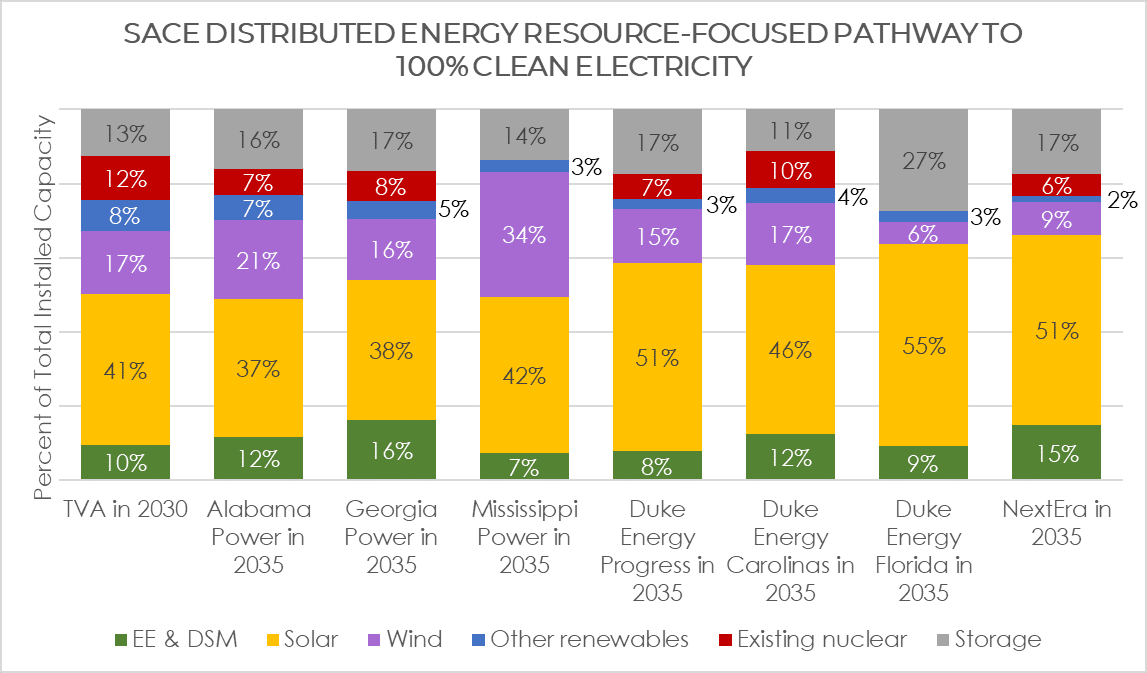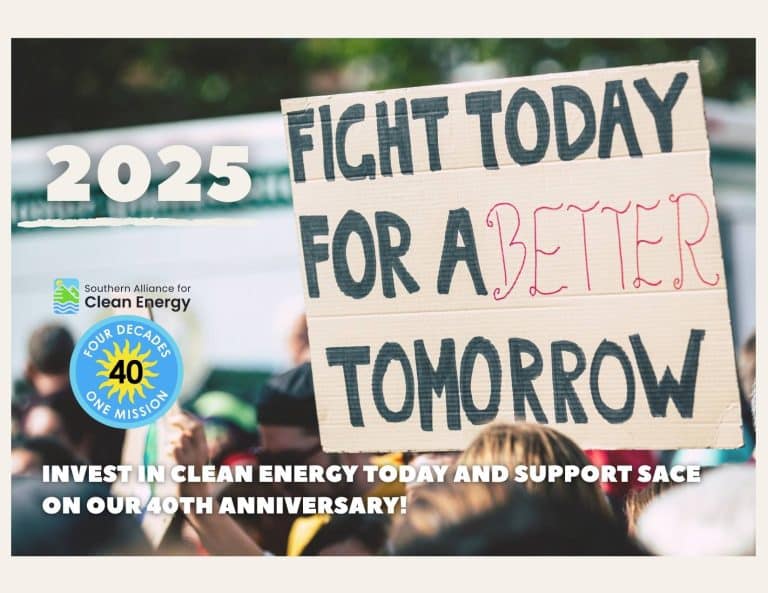A new SACE report, “Achieving 100% Clean Electricity in the Southeast: Enacting a Federal Clean Electricity Standard,” shows not only that is it possible for the four largest utilities in the Southeast to achieve 100% clean electricity, but there are several pathways to get there. A variety of different energy technologies and programs can be deployed to reach this goal. The key takeaway is that we need to start now.

[button color=”blue” url=”https://secure.everyaction.com/hMYlf_sW-02aMrPfTHGhTA2″]Download the Report [/button]
[button color=”blue” url=”https://cleanenergy.org/wp-content/uploads/SACE-CES-One-Pager-July-2021-1.pdf”]Learn more about a Clean Electricity Standard[/button]
[button color=”blue” url=”https://cleanenergy.org/news-and-resources/achieving-100-clean-electricity-in-the-southeast-report-webinar-on-duke-energy/”] Watch the Report Webinar on Duke Energy [/button]
[button color=”blue” url=”https://cleanenergy.org/news-and-resources/achieving-100-clean-electricity-in-the-southeast-report-webinar-on-nextera-energy/”] Watch the Report Webinar on NextEra Energy[/button]
[button color=”blue” url=”https://cleanenergy.org/news-and-resources/achieving-100-clean-electricity-in-the-southeast-report-webinar-on-tva/”] Watch the Report Webinar on TVA [/button]
[button color=”blue” url=”https://cleanenergy.org/news-and-resources/achieving-100-clean-electricity-in-the-southeast-report-webinar-on-southern-company/”] Watch the Report Webinar on Southern Company [/button]
[button color=”green” url=”https://secure.everyaction.com/YSD8hkgryEGN2wAxVeiZsQ2″]Take Action: Urge Congress to Pass a 100% Clean Electricity Standard[/button]
What is a Clean Electricity Standard?
A clean electricity standard is a policy that requires utilities to use clean energy resources to generate a minimum portion of all energy by a certain date. Since the first renewable standard was passed in Iowa in 1983 states and utilities across the U.S. have a lot of experience with this kind of policy. As part of federal climate action, the Biden administration and several members of Congress have proposed different versions of a Clean Electricity Standard (CES) that achieves 100% clean electricity by 2035. SACE has called for the Tennessee Valley Authority (TVA) to lead the way by getting to 100% clean electricity by 2030.
Pathways to a CES in the Southeast
To help us understand what 100% clean electricity would look like here in the Southeast, SACE staff developed pathways to meet a CES policy for our region’s four largest utility companies: TVA, Southern Company, NextEra (which owns Florida Power & Light and Gulf Power), and Duke Energy.
Our primary pathway is focused on distributed energy resources (DERs). We found that with significant and sustained investments in DERs, like energy efficiency and rooftop solar, these utilities can achieve a customer-oriented pathway to clean electricity. In fact, these two resources, energy efficiency and rooftop solar, could meet approximately one-third of all electricity needs for these utilities by 2035. In addition to these distributed resources, these successful pathways will also include wind power, large-scale solar, and energy storage. See the charts below for a snapshot of how this particular pathway to 100% clean electricity compares to current utility plans.

SACE staff also explored what a pathway to 100% clean electricity would look like if lower levels of distributed energy resources were achieved. Explore those results and more in the report, and watch one or more of our webinars for a dive deep into the results.
[button color=”blue” url=”https://cleanenergy.org/news-and-resources/achieving-100-clean-electricity-in-the-southeast-report-webinar-on-duke-energy/”] Watch the Report Webinar on Duke Energy [/button]
[button color=”blue” url=”https://cleanenergy.org/news-and-resources/achieving-100-clean-electricity-in-the-southeast-report-webinar-on-nextera-energy/”] Watch the Report Webinar on NextEra Energy[/button]
[button color=”blue” url=”https://cleanenergy.org/news-and-resources/achieving-100-clean-electricity-in-the-southeast-report-webinar-on-tva/”] Watch the Report Webinar on TVA [/button]
[button color=”blue” url=”https://cleanenergy.org/news-and-resources/achieving-100-clean-electricity-in-the-southeast-report-webinar-on-southern-company/”] Watch the Report Webinar on Southern Company [/button]
What makes getting to 100% clean electricity easier? Markets and innovation.
We found that when utilities have the ability to share resources to meet peak needs and reserve margins, fewer resources are needed overall. In most parts of the country, utilities already have the ability to do this through competitive electricity markets, but not in the Southeast. Having one such market that spans across the Southeast would help the region as a whole achieve 100% clean electricity.
Our analysis only looked at existing technologies. While it is good to know that today’s technologies can play a critical role in the pathway to 100% clean electricity, and so we must ramp up these technologies immediately, it is also true that investments in technology innovation are important to make it easier to get there. We still need to invest in research and development that can lead to improvements of existing clean electricity technologies and commercialization of new clean electricity technologies. This should not be a question of either deployment or research, both are needed.
The time for a federal CES is now

Tackling the climate crisis is our generation’s moonshot moment. What is the next step? Passing a federal Clean Electricity Standard. Use our tool to urge your members of Congress to support 100% clean electricity by 2035, or call Congress at 202-224-3121.
[button color=”blue” url=”http://bit.ly/cleanelectricityby2035″]Take Action: Send a Letter to Members of Congress [/button]



